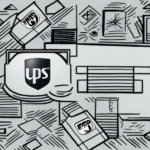Comparing FedEx and UPS Box Shipping Rates
When it comes to shipping packages, businesses have a choice between two of the largest shipping carriers in the US - FedEx and United Parcel Service (UPS). Both offer a range of shipping services with varying rates depending on the size, weight, destination, and urgency of delivery. In this article, we provide an in-depth comparison of FedEx and UPS shipping rates, services, and key factors to consider when choosing the best option for your business.
Understanding Shipping Rates: An Overview of FedEx and UPS Box Shipping
The shipping rates for FedEx and UPS vary based on the service type you choose. Both carriers offer their own shipping boxes in various sizes, from small to extra-large. FedEx provides four box sizes, while UPS offers five different sizes. Rates for both carriers depend on the box size, distance traveled, and delivery urgency.
Additionally, both FedEx and UPS offer additional services that can affect shipping rates. For example, services such as signature confirmation, hazardous material shipping, or specific delivery timeframes may incur extra fees. Furthermore, businesses that ship frequently or in large volumes can benefit from business discounts, potentially reducing overall shipping costs.
Shipping Cost Factors: What to Consider When Comparing Rates
When comparing rates between FedEx and UPS, consider the following factors:
- Package Weight and Dimensions: Both carriers use dimensional weight pricing, which considers the size of the package in addition to its weight.
- Delivery Location: Shipping to remote or international destinations may affect rates.
- Shipping Speed: Faster delivery options typically cost more.
- Package Type: Certain items, like hazardous materials or oversized packages, may have additional fees.
Utilizing FedEx and UPS cost calculators can help businesses evaluate their shipping needs and determine the most cost-effective carrier.
Moreover, it's crucial to verify each carrier's restrictions and fees for specific package types. For instance, shipping hazardous materials often requires special handling fees, which should be included in your cost analysis.
Domestic vs. International Shipping Rates: Which is More Cost-Effective?
FedEx and UPS offer different services and rates for domestic and international shipments. Generally, domestic rates for both carriers are comparable, while international rates can vary significantly based on the destination country, package size, and shipping speed.
Key considerations include:
- Customs Clearance: International shipments require additional documentation and may incur customs fees and taxes.
- Delivery Times: International shipments may face delays due to customs processing, weather conditions, or other factors.
- Shipping Rates: Compare rates using the provided calculators to determine the most economical option for each destination.
For detailed information on international shipping rates and services, refer to FedEx's and UPS's official resources.
Shipping Speeds: Which Carrier Offers Faster Delivery Times?
Both FedEx and UPS provide multiple shipping speed options, including standard, 2-day, and overnight delivery. FedEx often offers slightly faster delivery times than UPS for both domestic and international shipments. However, actual delivery times can vary based on location and selected service type.
When choosing a shipping speed, consider the following:
- Urgency: Faster delivery options are essential for time-sensitive shipments but come at a higher cost.
- Cost: Expedited shipping may not be necessary for all packages, and slower options can save money.
- Reliability: UPS is known for its reliable delivery record, which may outweigh speed considerations for some businesses.
For a comprehensive comparison, refer to recent delivery time statistics.
Package Tracking and Delivery Assurance: A Comparison of FedEx and UPS
Both FedEx and UPS offer robust package tracking systems, allowing businesses to monitor shipments in real-time. Additionally, both carriers provide delivery assurance to ensure packages arrive at the correct destination in good condition.
- FedEx: Offers comprehensive tracking and various delivery assurance options. However, standard services do not guarantee specific delivery times.
- UPS: Provides detailed tracking and a money-back guarantee on certain delivery services, enhancing customer confidence.
Businesses should consider the importance of delivery guarantees and the potential costs associated with each carrier's assurance options when making their decision.
Dimensional Weight vs. Actual Weight: How It Affects Your Shipping Costs
Both FedEx and UPS utilize dimensional weight pricing, which calculates shipping costs based on the package's size rather than just its weight. Dimensional weight is determined by multiplying the package's length, width, and height by a specific factor.
This means that larger packages with low actual weight may incur higher shipping costs compared to smaller, heavier packages. For example, a package measuring 20x20x20 inches with a low weight could be more expensive to ship than a compact package weighing 10 pounds.
Note that:
- Dimensional weight policies can vary between carriers. FedEx and UPS may use different factors for calculations.
- USPS only applies dimensional weight pricing to packages exceeding one cubic foot.
Understanding these calculations can help businesses optimize their packaging to minimize shipping costs. For detailed dimensional weight policies, refer to the official FedEx and UPS guidelines.
Additional Fees and Surcharges: A Detailed Look at Hidden Costs
Both FedEx and UPS impose additional fees and surcharges for specific services, such as remote area delivery, Saturday delivery, and oversized packages. To avoid unexpected costs, businesses should review each carrier's fee structure before selecting a shipping service.
- FedEx: Oversized package surcharges can reach up to $120 per package.
- UPS: Charges an additional $150 for packages exceeding 150 pounds.
Furthermore, optional services like signature confirmation, insurance, and delivery confirmation can increase overall shipping costs. It's essential to factor in these potential expenses when budgeting for shipping.
For a comprehensive list of FedEx and UPS fees, visit their respective websites.
Negotiating Better Rates with FedEx and UPS: Tips for Small Business Owners
Small business owners with regular shipping needs can negotiate more favorable rates with FedEx and UPS. Here are some strategies:
- Sign Up for Loyalty Programs: Both carriers offer loyalty programs that provide discounts based on shipping volume.
- Compare Multiple Shipping Rates: Regularly evaluate shipping costs across different carriers to ensure competitiveness.
- Negotiate Based on Volume: Use your shipping volume as leverage to secure lower rates.
- Consider Third-Party Shipping Services: Services like ShipStation or Shippo can negotiate better rates on your behalf.
Additionally, opening a business account with FedEx or UPS can provide access to exclusive discounts and benefits. Regularly reviewing and adjusting your shipping strategies can help maintain cost-effectiveness.
Customer Satisfaction Ratings: A Comparison of FedEx and UPS Services
Both FedEx and UPS boast high customer satisfaction ratings and have received multiple industry awards for their shipping services. According to recent Consumer Reports, both carriers maintain good overall customer satisfaction, with FedEx having a slight edge in certain categories.
When selecting a carrier, businesses should consider the following:
- Reliability: UPS is often praised for its reliability and consistent delivery performance.
- Customer Support: FedEx offers 24/7 customer support through phone, email, and live chat, whereas UPS provides similar support with limited weekend and holiday hours.
- Tracking and Transparency: Both carriers provide comprehensive tracking systems, but the depth of information and ease of use may vary.
Ultimately, evaluating customer satisfaction ratings in the context of your specific business needs is crucial for making an informed decision.
In conclusion, while FedEx and UPS offer comparable shipping services, their rates, additional fees, and service options can vary significantly based on your business's specific needs. Businesses should utilize shipping calculators, consider all relevant factors, and explore potential discounts to determine the most cost-effective and reliable shipping carrier. Additionally, negotiating better rates and optimizing shipping practices can further enhance efficiency and reduce costs.
For more detailed comparisons and tools, visit ShipScience.




















